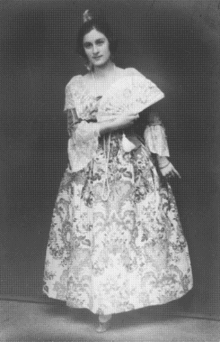Pia Ravenna
| Pia Ravenna | |
|---|---|
 | |
| Born |
Hjördis Sophie Tilgmann 25 October 1894 |
| Died | 19 October 1964 (aged 69) |
| Nationality | Finnish |
| Other names |
|
| Occupation | opera singer |
| Spouse(s) | Alessio Costa |
| Relatives | Arnold Tilgmann (brother) |
Pia Ravenna (born Hjördis Sophie Tilgmann, 25 October 1894; died 19 October 1964)[1] was a celebrated Finnish coloratura soprano who specialized in operatic works and was known as "the Nightingale of Finland".[1][2] Her artist name, Pia Ravenna, was based on her nickname "Pian" and Ravenna she found on the map of Italy.
Overview
Pia Ravenna had her debut in 1913 at the age of eighteen, and she gave her farewell concert in 1951.[1][2] According to her own books the coloratura soprano gave more than 800 performances in the span of 38 years, including 400 concerts and as many stage performances.[2] She never became internationally recognized but in Finland she was a leading soprano of the National Opera for more than a decade. She became famous for her technical agility and pearly light coloratura voice combined excellent stage presence.[citation needed] She kept record of her own performances and she appeared in 32 different operas and operettas over the years.
Biography
Early life
Pia Ravenna came from a musical family. Her brother Arnold Tilgmann was a tenor who combined a life in the printing business with a career on the operatic stage. Pia and Arnold gave concerts together. In 1935 at the Finnish National Opera they acted together, Pia as Rosina in Il barbiere di Siviglia and Arnold as Almaviva together with Feodor Chaliapin.
Early career
Pia Ravenna started her singing studies in Helsinki in 1910 with Elin Fohström-Tallquist. She gave her debut concert in 1913. In 1915 she went to St. Petersburg to continue her studies as a private student of Alma Fohström. Alma Fohström was a professor of singing at the St. Petersburg Conservatory after 10 years at the Bolshoy Theatre. In 1917 Pia Ravenna made her stage debut in 1917 at the Finnish Opera. As Rosina in Il barbiere di siviglia she was highly celebrated. During the following years she appeared as Rigoletto, Lakme, and Faust. She was very successful; however, she wanted to develop her singing talent. She continued her studies in Stockholm. In Sweden she studied with Madame Charles Cahier, and in Milan her teacher was Frederico Corrado. During her study she also gave concerts both in Finland and the Nordic countries.
International engagements
Besides giving concerts in Nordic countries Pia Ravenna appeared in 1921 at the Monte Carlo Opera with Nellie Melba. The singers also appeared together in Puccini's La Bohème. After Monaco she joined an Italian opera company in Egypt, Cairo, Alexandria and Port Said in 1921–1923. At that time she sang the coloratura parts in Il barbiere di Siviglia, Rigoletto, La Traviata, La Sonnambula and Lucia di Lammermoor. After her years in Egypt she spent most of the 1920s touring in Italy and Central and Eastern Europe, giving concerts and performing as a guest singer in opera houses from Berlin to Bucharest.
From the 1924s through to the 1940s
In 1924 Pia Ravenna married the singer Alessio Costa. The couple also appeared together; Costa accompanied her at the piano and sang duets with her. In 1929 the couple founded a private singing school, Studio Ravenna-Costa, where they both taught. Pia Ravenna also taught at the Helsinki Music Institute. The longest engagement was at the Finnish National Opera from 1928 to 1940. At this Opera Pia Ravenna appeared in standard repertoire. Frequently she sang in Il Pagliacci, Carmen and Die Zauberflöte. She performed with many guest artists her favorite was the Scottish Joseph Hislop. She appeared also in operettas in Madame Pompadour in 1928 and in the Spanish Nightingale in 1933 at the Swedish Theater in Finland. During the 1930s she made concert tours to Poland and Baltic countries. In 1948 she wrote a book called Guest play in Egypt that summed up her experience of the time in Egypt 1921-1923.[3]
Later life
Pia Ravenna gave her farewell concert at the Helsinki Conservatory in October 1951. Pia Ravenna spoke 6-7 languages and she used her language talent in translating Tex Willer when it arrived to Finland in 1953. After her retirement she gave singing lessons to students and travelled. Pia Ravenna died 1964 in Helsinki at the age of 69.
Recordings
Pia Ravenna was also famous for her broadcasts and her recordings. She performed on live radio broadcasts about one hundred times. Her records were regularly played on the radio.[4]
References
- ↑ 1.0 1.1 1.2 Hillila, Ruth-Esther & Blanchard Hong, Barbara 1997: Historical dictionary of the music and musicians of Finland. P. 335 ISBN 978-0313277283
- ↑ 2.0 2.1 2.2 Pia Ravenna: Una voce poco fa (yle.fi) (Finnish)
- ↑ Pia Ravenna Gästspel I Egypten (1948).
- ↑ Johanna Nuorivaara (2001) Pia Ravenna Recordings 1924-1929 Yle
External links
- Pia Ravenna: Una voce poco fa (Finnish)
- PIA RAVENNA (Hjördis Tilgmann)(soprano)
- http://www.dismarc.org/index.php?form=display&oaiid=YLE%3ARADIO_ARCHIVES%3AMUSIC_RECORDINGS%2F000002106077
- Pia Ravenna's aria performance in the opera Mireille